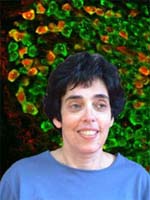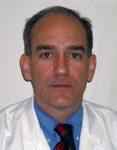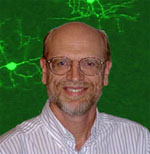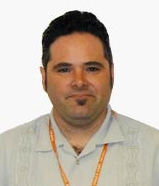Students interested in conducting research during the summer or academic year at the University of Tennessee Health Science Center may download an application form and an evaluation form. Consult the list below of UT faculty who have expressed an interest in sponsoring Rhodes students.
Please do not contact these faculty directly, but follow the procedures outlined in the application form. Contact Dr. Gary Lindquester for further information regarding course credit, summer support, and application procedures.
Students interested in a research in neuroscience may also apply for fellowship support at the following site: Rhodes/UT Neuroscience Research Fellowship.
 Name: Edward Chaum, MD, PhD
Name: Edward Chaum, MD, PhD
Department: Hamilton Eye Institute
Phone: 901-448-3638
Email: echaum@uthsc.edu
URL: http://www.eye.uthsc.edu/
dept/faculty/echaum.html
Project Title: Nanomaterial Applications in Ophthalmic Surgery
Project Summary: Development and testing of novel materials for applications in ophthalmic surgery. Methods include light and confocal microscopy, materials testing, and cellular and molecular biology.
 Name: Julio F. Cordero-Morales, PhD
Name: Julio F. Cordero-Morales, PhD
Department: Physiology
Phone: 901-448-8206
Email: jcordero@uthsc.edu
URL: http://corderovasquezlab.weebly.com/
(This lab may provide a summer stipend.)
Project Title: Studying TRP and Piezo channels for strategies to diminish neuropathic pain.
Pain is essential for survival and well-being. However, under certain conditions (diabetes, cancer, chemotherapy, heredity, infections, toxins) pain can become debilitating and decrease the quality-of-life of affected individuals. Neuropathic pain involves severe symptoms including stabbing pain, burning, tingling, loss of mechanical and thermal sensation, pressure and cold hypersensitivity, and balance problems. Transduction of painful stimuli involves excitatory ion channels, such as the transient receptor potentials (TRP) and Piezo channels at specialized sensory neurons that innervate our skin and organs. These channels respond to a variety of physical (e.g., heat and pressure) and chemical (e.g., fatty acids and cellular factors) stimuli to elicit or intensify pain.
Our goal is to elucidate the role of TRP and Piezo channels by delineating structural domains involved in channel activation, and identifying molecules that modulate its activity. We also seek to determine the contribution of bioactive lipids (released during inflammation) to TRP and Piezo activities in the context of the model worm Caenorhabditis elegans, since it has proven to be an excellent system to study pain.
Students will be directly involved with:
1- Functional determination of TRP channels using electrophysiology. Techniques in this project will include: molecular biology, cell culture, membrane protein purification, and patch-clamp technique.
2- Characterization of the interaction between Piezo and bioactive lipids in C. elegans. Techniques in this project will include: molecular biology, genetics, behavioral assays, RNAi, and in vivo Ca+2 imaging.
 Name: Valeria Vaxquez, PhD
Name: Valeria Vaxquez, PhD
Department: Physiology
Phone: 901-448-7223
Email: vvasquez@uthsc.edu
URL: http://corderovasquezlab.weebly.com/
(This lab may provide a summer stipend.)
Project Title: Studying TRP and Piezo channels for strategies to diminish neuropathic pain.
Pain is essential for survival and well-being. However, under certain conditions (diabetes, cancer, chemotherapy, heredity, infections, toxins) pain can become debilitating and decrease the quality-of-life of affected individuals. Neuropathic pain involves severe symptoms including stabbing pain, burning, tingling, loss of mechanical and thermal sensation, pressure and cold hypersensitivity, and balance problems. Transduction of painful stimuli involves excitatory ion channels, such as the transient receptor potentials (TRP) and Piezo channels at specialized sensory neurons that innervate our skin and organs. These channels respond to a variety of physical (e.g., heat and pressure) and chemical (e.g., fatty acids and cellular factors) stimuli to elicit or intensify pain.
Our goal is to elucidate the role of TRP and Piezo channels by delineating structural domains involved in channel activation, and identifying molecules that modulate its activity. We also seek to determine the contribution of bioactive lipids (released during inflammation) to TRP and Piezo activities in the context of the model worm Caenorhabditis elegans, since it has proven to be an excellent system to study pain.
Students will be directly involved with:
1- Functional determination of TRP channels using electrophysiology. Techniques in this project will include: molecular biology, cell culture, membrane protein purification, and patch-clamp technique.
2- Characterization of the interaction between Piezo and bioactive lipids in C. elegans. Techniques in this project will include: molecular biology, genetics, behavioral assays, RNAi, and in vivo Ca+2 imaging.
 Name: Ioannis Dragatsis, PhD
Name: Ioannis Dragatsis, PhD
Department: Physiology
Phone: 901-448-3615
Email: idragatsis@uthsc.edu
URL: https://uthsc.edu/neuroscience/faculty/I_Dragatsis.php
Project Title: Analysis of a mouse model for Familial Dysautonomia
Project Summary: Familial Dysautonomia (FD) is an autosomal recessive disorder that affects 1/3,600 live births in the Ashkenazi Jewish population, leading to death before the age of 30. The disease is characterized by progressive degeneration of the sensory and autonomic nervous system. Despite the identification of the gene that causes FD (Ikbkap) and recent medical advances, no cure is available. We have generated a mouse model recapitulating the phenotypic features of the disease and our goal is to elucidate the mechanisms that lead to neuronal degeneration in FD and to test therapeutic strategies.
Project 2 Title: Analysis of the normal function of huntington
Project Summary: Huntington’s disease (HD) is an autosomal dominant disorder that affects 1 in 10,000 individuals. HD is characterized by chorea, rigidity and progressive dementia. Symptoms usually begin between the ages of 35 and 50 years, with death typically following 15 to 20 years later. HD is caused by the expansion of an unstable stretch of CAG triplet repeats within the coding region of the HD gene. Moreover the protein encoded by the HD gene, huntingtin, is a novel protein of unknown function.
We are using the mouse as a model organism. Inactivation of the mouse homologue of the HD gene results in embryonic lethality demonstrating that huntingtin is essential for early embryonic development. Conditional inactivation of the gene at later stages results in progressive neurodegeneration in the adult mouse, suggesting that huntingtin is also essential for neuronal survival.
Name: Maria Gomes-Solecki, DVM
Department: Molecular Sciences
Phone: (901)448-2536
Email: mgomesso@uthsc.edu
URL: http://www.uthsc.edu/molecular_sciences/directories/faculty/m_gomes.php
(This lab may provide a summer stipend.)
Title of Project: Oral Vaccines for Microbial Pathogens and Allergens
Project Summary (in non-technical terms):Our most challenging project relates to the development of a vaccine against peanut allergy. Peanut allergy is the major cause of fatal or near-fatal anaphylactic reactions to foods and affects 0.6% of US population. There is no vaccine available for peanut allergy and traditional immunotherapy using native peanut protein causes a high incidence of adverse reactions. We plan to develop oral vaccines in Lactobacillus plantarum and Lactobacillus casei, expressing three peanut allergens Arah1, Arah2 and Arah3, which have altered primary aminoacid sequences of the reactive IgE-binding epitopes. The major goal of this project is to test the efficiency of these oral vaccines in a mouse model of peanut allergy.
Another project relates to the development of a human oral vaccine against a Category B select agent, Burkholderia pseudomallei using the same Lactobacillus based platform technology described above. B. pseudomallei is a saprophyte that can be isolated from soil and is the causative agent of melioidosis in humans.
Name: Weikuan Gu, PhD
Department: Orthopaedic Surgery
Phone: 901-448-2259/577-7269
Email: wgu@uthsc.edu
(This lab may provide summer stipend.)
Title of Project: Genetic and Genomic basis of human disease using mouse models
Project Summary (in non-technical terms): We are studying the genetic and genomic basis of human diseases using mouse models. Several mouse mutants in our laboratory show the phenotype of human diseases. Phenotypes of those mutations include bone fracture, arthritis, and ataxia. We are using molecular tools such as microarray, and real time PCR to study the genetic pathways of the disease development and potential treatment.
 Name: Marcia Honig
Name: Marcia Honig
Department: Anatomy & Neurobiology
Phone: 448-5998
Email: mhonig@uthsc.edu
URL: http://www.uthsc.edu/neuroscience/faculty/M_Honig.php
(This lab may provide summer stipend.)
Title of Project: Traumatic brain injury
Project Summary: The research in my laboratory is focused on examining the behavioral consequences of traumatic brain injury (TBI) and the associated pathological changes, through the use of a mouse model. We create the injury by delivering a high-pressure air blast to a restricted part of one side of the cranium, after anesthetizing and stabilizing the mouse to restrict its movement and shielding the rest of the head and the entire body from the blast. In terms of the biomechanical forces produced by the air blast, the functional deficits exhibited by the mice, and the widespread axonal injury later observed with histological analysis, our model very much mimics the mild TBI (i.e. concussion) sustained by humans during traumatic incidents such as sports injuries, motor vehicle accidents, and falls, where the skull remains intact. Accompanying the initial axonal injury, microglia become activated and the ensuing neuroinflammation contributes to further pathogenesis. We are currently pursuing this in two ways. First, we are utilizing a pharmacological agent that modulates microglia in such a way as to improve the outcome from TBI, and may also provide benefit in neurodegenerative diseases such as Alzheimer’s and ALS where neuroinflammation contributes to disease progression. Secondly, we are examining how neuroinflammatory responses contribute to long-term decline, particularly with regard to cognitive function and following multiple traumatic events.
Name: Monica M. Jablonski, PhD
Department: Opthalmology
Phone: 901-448-7572
Email: mjablonski@uthsc.edu
(This lab may provide a summer stipend.)
Project Title: Genetic modulation of glaucoma
Project Summary (in non-technical terms): This project involves processing optic nerve samples and embedding them in plastic. After sectioning, the nerves will be assessed for damage.
 Name: Mark LeDoux, MD, PhD
Name: Mark LeDoux, MD, PhD
Department: Department of Neurology, Department of Anatomy and Neurobiology
Phone: (901) 448-1662
Email: mledoux@uthsc.edu
(This lab may provide a summer stipend.)
Project Title: Genetics and pathobiology of primary dystonia
Project Summary: Using vertebrate and invertebrate models, human lymphoblastoid and fibroblast cell lines, and stable transfected cell lines, we study the cellular and systems biology of dystonia-associated proteins.Genetic contributions to late-onset primary dystonia are being examined with whole-exome and whole genome sequencing with integrated linkage analysis and RNA-seq. We also utilize candidate gene, genome-wide association and whole-genome gene expression studies.
Mechanisms of neurodegeneration in Parkinson disease: several members of the tetrahydroisoquinoline (TIQ) family of monoamine alkaloids can be formed from dopamine or its oxidized metabolites and may be involved in the pathogenesis of monoaminergic cell death in Parkinson disease. To examine the potential role of TIQs in monoaminergic cell death, we have used enantiomeric-selective high-performance liquid chromatography with electrochemical detection, liquid chromatography with tandem mass spectroscopy, cell culture studies of neurotoxicity and assays of mitochondrial membrane potential.
Clinical trials of therapeutic interventions for movement disorders (dystonia, Huntington disease, Parkinson disease, restless legs syndrome)
Anatomy and computational organization of motor systems:
The neural networks mediating suprasegmental control of the blink reflex and spontaneous blinking remain poorly understood. Viral transneuronal tracing is being used to define the integrated premotor cortical and subcortical control of levator palpebrae and orbicularis oculi motoneuron activity.
In isolation or via interactions with striatal-thalamo-cortical pathways, olivocerebellar structures play a critical role in disorders of motor control such as ataxia and dystonia. Using neurophysiological and molecular tools, we are dissecting the relative roles of individual network elements in the positive and negative signs characteristic of individual movement disorders.
 Name: Len Lothstein, PhD
Name: Len Lothstein, PhD
Department: Pharmacology
Phone: 901-448-3334
Email: llothstein@uthsc.edu
(This lab may provide summer stipend.)
Project Title: Antitumor and Cardioprotective Mechanisms of Cytoplasmic PKC Targeting Agents
Project Summary: Successful chemotherapeutic treatment of cancer is often limited by the development of drug resistance within the tumor cells and adverse systemic drug effects, particularly cardiotoxicity, which can be life-threatening. This project analyzes the mechanisms of action of a novel class of targeted antitumor agents. The apparent ability of the drugs to circumvent cellular drug resistance and act in a cardioprotective manner confers upon this class of targeted agents the potential to successfully treat refractory tumors with reduced toxicity for the patient.
 Name: Khyobeni (Beni) Mozhui
Name: Khyobeni (Beni) Mozhui
Department: Preventive Medicine
Email: kmozhui@uthsc.edu
URL: https://academic.uthsc.edu/faculty/kmozhui.html
Project Title: Genetics and epigenetics of heath and aging
Project Summary: Our ongoing work is related to the genetics and epigenetics of aging and how such molecular biomarkers associate with the development, health, and lifespan of an individual. The work we do is multidisciplinary in nature and involves both laboratory research and extensive analysis of epidemiological and high-dimensional genome-wide datasets. We apply different molecular techniques to assay different features of the epigenome and gene expression. We take a cross-species comparative approach and incorporate both model organisms and humans. Currently, we are performing studies in an aging cohort of genetically divergent inbred mouse strains. Additionally, we utilize human biobanked specimens and data accrued from epidemiological cohorts to test the conservation and translational utility of our findings. Identifying epigenetic and transcriptional features that are conserved across mammalian species will provide insights into the fundamental process of biological aging, and perhaps present targets to modify aging and health trajectories.
 Name: Marko Radic, PhD
Name: Marko Radic, PhD
Department: Molecular Science
Phone: 901-448-8219
Email: mradic@uthsc.edu
URL: http://www.uthsc.edu/molecular_sciences/directories/faculty/m_radic.php
(This lab may provide summer stipend.)
Project Title: Treating Autoimmunity and Cancer with Engineered Host T Cells
Project Summary: New approaches to genetically engineer host cytotoxic T cells currently constitute the most vibrant branch of cancer immunotherapy. Most gratifying advances have been achieved with T cells that express chimeric antigen receptors (CARs) to CD19 on B cells and that induce remission in B cell leukemias. We have adopted this technology to additional questions of interest to our lab. One application of CAR T cells that we pursue is as a new treatment for autoimmune disease. A second application is in solid tumors that present unique challenges to CAR immunotherapy. We use mouse models for the human disorder. The summer student(s) could participate in various aspects of this research depending on prior experience and interest.
 Name: Anton Reiner, PhD
Name: Anton Reiner, PhD
Department: Anatomy & Neurobiology
Phone: 901-448-8298
Email: areiner@uthsc.edu
URL: http://www.uthsc.edu/neuroscience/faculty/A_Reiner.php
(This lab may provide summer stipend.)
Title of Project 1 : Animal Tests of Huntington’s Disease Treatments
Project 1 Summary: Using genetically engineered mouse models of Huntington’s disease, we use behavioral and histological methods to assess the ability of various treatments to slow Huntington’s disease progression. Treatments include a novel gene therapy involving DNAzymes and drug therapy using anti-excitotoxic or pro-neurotrophic compounds.
Title of Project 2: Traumatic nervous system injury in a mouse model
Project 2 Summary: The research in my laboratory is focused on traumatic brain injury (TBI), using a high-pressure air blast to the left side of the head of an anesthetized mouse to model TBI. This damages axons located in major fiber tracts and activates microglia along those tracts, without causing any hemorrhaging or contusive injury. Behavioral assays indicate that mice subjected to TBI exhibit mild motor deficits, significant visual deficits, depression, anxiety and fear, when tested 2 weeks – 2 months after the TBI event. We are currently directing most of our attention to the long-term consequences of TBI and extending our approach to model multiple concussive events. In collaborative work with Marcia Honig, we have found that repetitive mild TBI results in neuronal loss in several areas of the brain and in the spinal cord. The mice exhibit psychological, cognitive, and motor impairments, with some of these deficits increasing in severity over time. We are particularly interested in determining how neuroinflammatory responses and auto-antibody production contribute to pathogenesis following repetitive TBI and in understanding how a history of concussion leads to the development of chronic traumatic encephalopathy (CTE) and an increased risk of amyotrophic lateral sclerosis (ALS) and Alzheimer’s disease
 Name: Lawrence T. Reiter, Ph.D.
Name: Lawrence T. Reiter, Ph.D.
Department: Neurology
Phone: 901-448-2635
Email: lreiter@uthsc.edu
(This lab may provide summer stipend.)
Project Title: Ube3a regulation of the fly nervous system.
Project Summary: We have identified changes in synaptic boutons in the fly larval neuromuscular junction that appear to be dependent on both Ube3a and at least one protein regulated by Ube3a in flies called Pbl. The goal of this project is to generate double mutants for Ube3a and Pbl as well as Ube3a and Rac1/Rac2 (genes downstream of Pbl) in order to determine which aspects of the bouton number, bouton tract length and morphology are related to regulation by fly Ube3a. The student should have a basic understanding of genetics, but we will teach them fly genetic methods. This project will also involve dissection and antibody staining of fly neuromuscular junctions as well as statistical analysis of changes in bouton size and number.
 Name: Amali E. Samarasinghe
Name: Amali E. Samarasinghe
Department: Pediatrics
Email: amali.samarasinghe@uthsc.edu
URL: samarasinghelab.org
(This lab may provide summer stipend.)
Title of Project: Determining the impact of respiratory infections in allergic asthma
Project Summary: Our laboratory is dedicated to understanding immune mechanisms that underlie host-pathogen responses in hosts with underlying airways disease utilizing cutting edge technologies in immunology, microbiology, and virology.
Name: Tiffany N. Seagroves, PhD
Department: Pathology
Phone: 901-448-5018
Email: tseagro1@uthsc.edu
(This lab may provide summer stipend.)
Our long-term goal is to identify why some breast cancers become metastatic and to reduce mortality associated with metastatic breast cancer (MBC) by targeting novel pathways that drive tumor progression and metastasis. Tissue hypoxia (depletion of oxygen) is a hallmark of most solid tumors, including breast cancers. In response to hypoxic stress, tumor cells must adapt to their hostile microenvironment by quickly regulating expression of genes that control angiogenesis, glycolytic metabolism, cell division, cell survival and motility. The hypoxic response is highly clinically relevant to MBC since hypoxic tumor cells are refractory to both chemotherapy and radiation and since hypoxia stimulates tumor cell migration and metastasis to distant organs.
A major challenge in the clinic is to prevent breast cancer patient relapse and mortality due to treatment-refractory metastatic disease. Accumulating evidence suggests that dysregulated tumor cell metabolism and drug resistance are intimately linked. Tumor hypoxia drives changes in cellular metabolism, enhances metastasis and promotes therapeutic resistance through activation of a hypoxic response orchestrated by the oxygen-responsive Hypoxia Inducible Factor (HIF) transcription factors. Yet, directly targeting the HIFs is challenging as they are localized to the nucleus and they regulate hundreds of genes. Another roadblock is that most of the current “HIF” inhibitors indirectly rather than directly impact HIFa protein stability or transcriptional activity. Therefore, we decided to approach this problem by identifying genes downstream of the HIFs that are essential for metastatic phenotypes. We use a variety of state of the art approaches to silence or to over-express HIFs or genes downstream of the hypoxic response to understand which pathways may be most amenable to developing small molecule inhibitors with anticancer activity to test in future clinical trials. We use a variety of transgenic mouse models, murine or human breast tumor cell lines, and patient-derived xenograft (PDX) models that represent all major subtypes of breast cancer. We also have access to primary patient samples and to breast tumor tissue microarrays through our collaborations with the UTHSC Dept. of Pathology and The West Cancer Center, a partnership among The West Clinic, UTHSC and Methodist University Hospital.
Name: Michael Whitt, PhD
Department: Molecular Sciences
Phone: (901)448-4634
Email: mwhitt@uthsc.edu
URL: http://www.uthsc.edu/molecular_sciences/directories/faculty/m_whitt.php
Title of Project: “Development of oncolytic vectors for the treatment of glioblastoma”
Project Summary (in non-technical terms): Glioblastoma multifome (GBM), a highly invasive and aggressive form of brain cancer. Conventional therapies, such as surgery, radiation and chemotherapy are able to reduce the tumor burden and extend the survival of patients with GBM by a few months; however, these treatments rarely result in cure due to the invariable recurrence of tumor near the primary foci; therefore, novel therapies for the treatment of GBM are urgently needed. As an alternative to standard of care therapies, we are developing novel viral vectors that are designed to be oncolytic (e.g. onco = tumor, lytic = killing) for the treatment of brain tumors. Specifically, we are using molecular biology techniques to create recombinant vesicular stomatitis viruses that have multiple mutations in the matrix gene which make them non-cytopathic for normal cells, but that retain efficient cytolytic properties against tumor cells. The project will involve use of PCR-based mutagenesis to generate novel matrix mutations followed by transfection of cells with plasmids encoding the mutant proteins in culture to evaluate their cytopathic potential. Mutations that have desirable oncolytic properties will be used to create novel recombinant viruses which will then be tested in a rat model of GBM.
Name: Dahui You 
Department: Pediatrics
Email: dyou@uthsc.edu
Title of Project: The role of the microbiome in respiratory disease severity
The project will investigate the role of gut/airway microbiome in determining the disease severity in either RSV or influenza disease severity. We will sequence the 16s DNA in the stool or nasal wash samples that we collected from RSV or influenza infected patients and perform bioinformatics and statistical analysis on them. We will also use mouse models to study the effects of gut/airway microbiota on the development of the immune system and its response to RSV or influenza infection. In the process, students will have the chance to learn bioinformatics and many techniques in immunology and cellular biology.
 Name: Fu-Ming Zhou, PhD
Name: Fu-Ming Zhou, PhD
Department: Pharmacology
Phone: 901-448-1779
Email: fzhou3@uthsc.edu
URL: http://www.uthsc.edu/neuroscience/faculty/F_Zhou.php
(This lab may provide summer stipend.)
Project Title: Brain Dopamine and Serotonin
Project Summary: Study the cellular and molecular mechanisms of the brain dopamine and serotonin systems in drug addiction, depression, schizophrenia, and Parkinson’s disease.